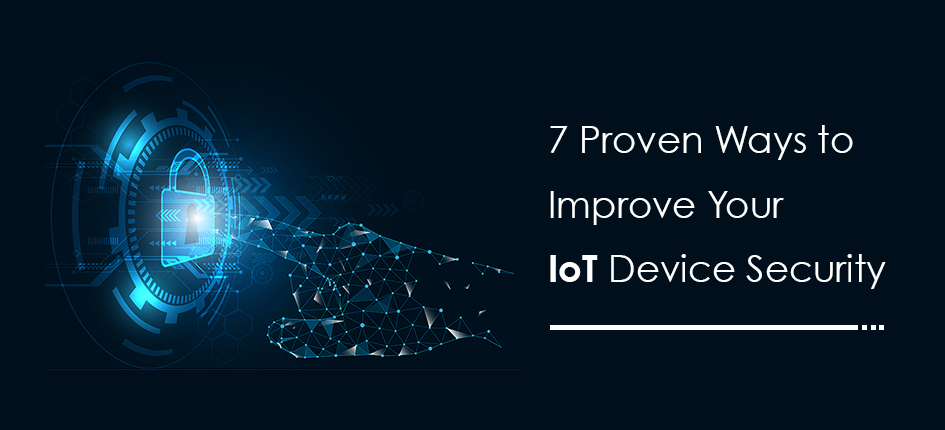7 Proven Ways to Improve Your IoT Device Security

Internet of Things is driving connectivity and convergence between everything. Amidst the emerging technologies and ever-changing trends, IoT smartly connects businesses and customers in this digitally-driven world. However, it also prompts hackers and attackers to commit data breaches.
We can’t gainsay the fact that businesses perceive IoT as a boon for their growth, but due to lack of security checks, this emerging technology can also turn into a bane for them. Initially, it will result in data loss, but as the ripples spread, it will end up in a slew of losses – tangible as well as intangible.
Thus, when every type of data, including employees, customers, business, infrastructure, etc. are prone to risks, it is crucial to take measures that improve the security layer of a myriad of devices and networks connected through the Internet of Things.
Future of the Internet of Things and Need for Security Enhancement
According to our perception, the future of IoT is invincible. Statista reports say that there will be about 36M connected IoT devices worldwide by 2021. Therefore, businesses from all the industries, including agriculture, healthcare, energy, retail, and oil and gas are set to leverage the future opportunities brought forth by IoT.
With billions of devices connected via IoT, a massive amount of data is generated. However, the lack of effective security protocols increases the susceptibility to hacking. For the seamless and secure functioning of IoT devices, businesses must follow risk-aware approaches and enterprise-grade practices to create a secure infrastructure.
How to Overcome IoT Security Challenges
When IoT was at its nascent stage, security, perhaps, wasn’t a much-focused factor. However, given the IoT security challenges, data breaches, and continually increasing cybercrime, it has become imperative for businesses to embrace IoT security protocols and techniques to ensure improved data security to your valuable data. Below, we have outlined a few tips that you can follow to overcome the IoT security challenges as well as apprehensions.
IoT Security Analytics
IoT app developers usually deploy IoT devices in different environments. Therefore, it necessary to track the activities of various IoT devices using IoT security analytics. This approach helps the businesses in the structured garnering of data generated by a variety of devices and networks connected via IoT. It also easily monitors the behavioral change in data processing and reduces the possibilities of data breaches.
Public Key Infrastructure (PKI)
The growing rate of hacking and data breaches has resulted in a surge in demand for PKI. PKI is a set of protocols on which digital certificates are issued after a registration process. The registration process records devices, users, or identities and allows businesses to spot unidentified users instantly. Thus, you can keep communication channels safe and secure.
Device Authentication
Device authentication is a potent mechanism for the authentication of billions of connected devices. With robust passwords protocols, integration of two-factor authentications, and many other practices, you can analyze as well as scrutinize every device trying to connect to the network.
Secured Internet Network
The network vulnerability is in direct proportion to hacking and can experience DDoS (Distributed Denial-of-Service) attacks, for example. These attacks disrupt the functioning of connected devices and often generate inappropriate or misguiding data. In such cases, a secured internet network must be used at places where IoT devices are implemented and run.
Secured Cloud Platforms
Most businesses use the cloud to store massive data generated by IoT devices. Hence, it is vital to secure the cloud platforms which communicate data with IoT devices. Besides, you should also protect and update passwords at regular intervals, implement provisions to block the account, for a defined timeframe, after multiple failed login attempts. Two-level security features will also add an extra level of security.
Encrypted Security layers
In most cases, IoT devices are not developed with security layers and are highly vulnerable. Thus, it is essential to incorporate encrypted security layers into your IoT device during its development. Also, the devices should be developed with updates operating systems and robust as well as high-performance hardware that secures the entire data exchange process. This would lead to a safe environment for storing and communicating data.
Software Update
In various industries, IoT devices, connected to sensors, are embedded in remote areas to glean data. Therefore, the software update for these devices becomes vital as it protects them from hacking and data breaches. The updated software and firmware also facilitate the incorporation of new features into IoT devices besides helping in identifying and eradicating security bugs.
Conclusion
Whether the nascent cyber laws can deal with cybercriminals or not, the demand for secure IoT products has been continually rising in the maturing market. News reports inform that the IoT security market in North America is anticipated to grow approximately by 25% annually, and this growth will be fueled by continuously increasing demand for IoT device security solutions and cloud-based enterprise apps. Likewise, other regions of the world will also witness a surge in demand for IoT security solutions, depending on the increasing use of IoT devices as well as networks.

